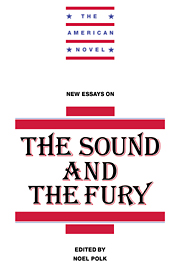Book contents
- Frontmatter
- Contents
- Series Editor's Preface
- 1 Introduction
- 2 Faulkner's Text Which Is Not One
- 3 “Now I Can Write”: Faulkner's Novel of Invention
- 4 Quentin Compson: Tyrrhenian Vase or Crucible of Race?
- 5 Trying Not to Say: A Primer on the Language of The Sound and the Fury
- Notes on Contributors
- Selected Bibliography
5 - Trying Not to Say: A Primer on the Language of The Sound and the Fury
Published online by Cambridge University Press: 23 December 2009
- Frontmatter
- Contents
- Series Editor's Preface
- 1 Introduction
- 2 Faulkner's Text Which Is Not One
- 3 “Now I Can Write”: Faulkner's Novel of Invention
- 4 Quentin Compson: Tyrrhenian Vase or Crucible of Race?
- 5 Trying Not to Say: A Primer on the Language of The Sound and the Fury
- Notes on Contributors
- Selected Bibliography
Summary
FLOWER spaces that curl, a fence, a search, a table, a movable flag, and a pasture in which people are “hitting,” all without any apparent relationship to one another, dot the visual landscape of the opening lines of The Sound and the Fury. And, as if the first paragraph didn't throw enough problems at the reader, the opening words of the second paragraph, the novel's first spoken words – “Here, caddie.” – are relayed to us by the same narrator who has thrown us asea in the first paragraph, who transmits them without identifying their source, and who misunderstands them. They contain an aural pun, a homophone, and are related, though we don't yet know how, to the narrator's inexplicable reaction. Careful readers will pretty quickly figure out that the narrator is looking through the fence at a golf course, and a really alert reader might, even this early, suspect that the course was once a pasture, and so be able to negotiate an uneasy narrative collaboration with the opening paragraph; but these two “spoken” words, which both are and are not what they seem to be, throw us back into uncertainty.
For the speaker, the word “caddie” has a specific, unproblematic referent, and he or she assumes that the person holding the golf clubs will know what he or she means; readers, who see the words' written representations rather than hear their sounds, perforce share this assumption and adduce from it that the speaker is probably a golfer (the speaker could be a supervisor or even somebody on the narrator's side of the fence who needs the caddie's attention for some reason).
Information
- Type
- Chapter
- Information
- New Essays on The Sound and the Fury , pp. 139 - 176Publisher: Cambridge University PressPrint publication year: 1993
Accessibility standard: Unknown
- 1
- Cited by
